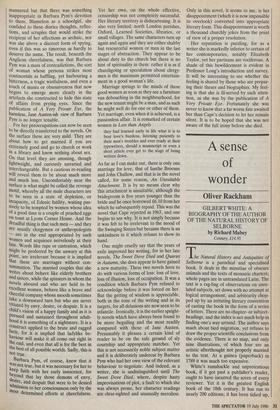A sense of wonder
Oliver Rackham
GILBERT WHITE: A BIOGRAPHY OF THE AUTHOR OF THE NATURAL HISTORY OF SELBORNE by Richard Mabey
Century, £14.95
The Natural History and Antiquities of Selborne is a parochial and specialised book. It deals in the minutiae of obscure animals and the texts of monastic charters; whole pages are in untranslated Latin. The text is a rag-bag of observations on unre- lated subjects, set down with no attempt at logical arrangement, and arbitrarily chop- ped up by an irritating literary convention of casting the book in the form of a series of letters. There are no chapter- or subject- headings, and the index is not much help in finding one's way around. The author says much about bird migration, yet refuses to draw the proper scientific conclusions from the evidence. There is no map, and only nine illustrations, of which four are an artistic afterthought not properly married to the text. At a guinea (paperback) in 1789 it was much too expensive.
White's ramshackle and unpretentious book, if it got past a publisher's reader, ought to have incurred the scorn of every reviewer. Yet it is the greatest English book of the 18th century. It has run to nearly 200 editions; it has been tidied up, bowdlerised, and translated. It is one of the few books that have changed our national character, making the English into a nation of birdwatchers. It has won the hearts of countless Americans who have never seen any of the creatures White wrote about. It has shaped the lives of two centuries of naturalists, including the pre- sent author and his reviewer.
Richard Mabey has tried to find out what it was that gave White this mysterious power over posterity. Some biographers have been tendentious, presenting White as a recluse, a 'primitive', or even a saint. Mabey, although an eloquent writer on behalf of rural conservation, avoids the temptation to recruit White to his own campaign; instead he has sought for more facts among White's manuscripts and among the archives of Selborne parish and the Oxford colleges.
White was outwardly a very ordinary figure, a half-employed country parson living on modest private means. His chief responsibility was the care of an extended family. He enjoyed his food and wine. He was no recluse: he kept up a tenuous connection with Oxford academic life. He went as far as Devon and the Fens, but refused to travel to Yorkshire (then a more difficult and expensive journey than going to Texas is now). He was just one of thousands of upper-middle-class country- men. His interest in natural history de- veloped quite late, and he published no- thing until the age of 54.
Mabey is the greatest evoker of the genius loci and delights in the special and wonderful landscape of White's home. Selborne was (and is) a product of the Anglo-Saxon age or earlier, still full of holloways, pollards, ancient hedgerows, heaths and wood-pasture commons. (Alas, Mabey gives us no modern photographs to compare with the original illustrations to the Natural History.) Such an extreme piece of Ancient Countryside is rich in unusual wildlife, and in White's time was richer still: we can envy him the sight of 40 ravens together, or the sound of that amazing animal the mole-cricket.
White's good fortune to live in such a place does not explain the power of his book: others have lived in Selbome, and there are other Selbornes, but there is no other Natural History. He was a disting- uished gardener, but that if anything is an anti-qualification for being a good natural- ist. He was a first-class observer, but there have been other first-class observers, and none of them (save Linnaeus and Charles Darwin) has rivalled the fame and influ- ence of Gilbert White.
In what, then, does the genius of White reside, and what can we learn from his example? For all his disorganisation, he is a supremely readable writer: Selborne stands among those books — St Jerome's and King James's Bibles, The Origin of Species, Freud's Die Traumdeutung which display the formidable power by which a writer of excellent prose, whatever his message, may change the world. We may never know how White acquired the art (it is there in his earliest manuscript writings), but need it be so despised and neglected today? Need scientists attach so little importance to getting their work widely read? Why has the modern con- servation movement so quickly buried it- self in repetitive claptrap and repellent jargon?
White's other rare quality is his sense of wonder and delight and curiosity in the natural world. Most of us have this faculty as children but lose it in our teens. White, uniquely, seems to have regained it at the age of 41, and it gave him a flow of new questions and ideas until the month of his death. I am sad to find how rare this sense is now, even among professional ecolog- ists; how few of them keep diaries; and how seldom biology students carry note- books to record casual observations as found. How can we stop education from killing the sense of wonder?
Mabey himself shares these qualities of his hero: he is one of the most vivid ecological writers of our time, and he still has a sense of wonder and delight. I thoroughly commend this prelude to the edition of White's complete works which he is preparing.



















































 Previous page
Previous page